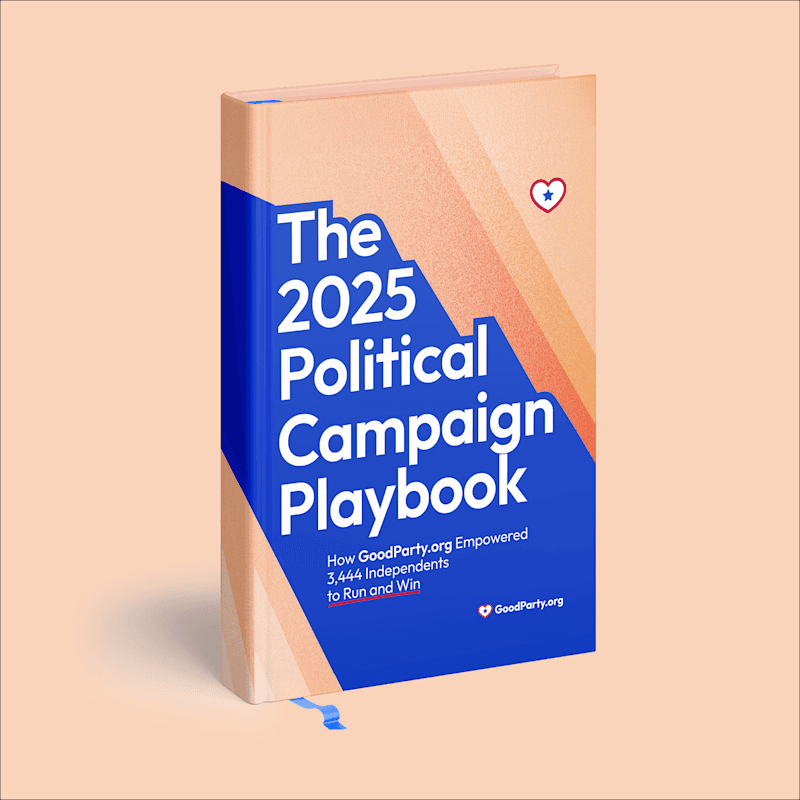
Volunteers: Bridging a Gap Between Campaign and Constituent
In the realm of political campaigns, there exists a life-sustaining artery connecting the beating heart of a candidate's message to the body of the electorate: the volunteer. Grassroots engagement, which is critical for all successful political campaigns, is at the center of a thriving democratic process.
For independent candidates, who often lack the structural and financial backing of establishment parties, volunteers are not just important — they’re indispensable.
Why Grassroots Engagement is Essential
Volunteers serve as the campaign's frontline emissaries. They’re local residents, neighbors, and community members who lend authenticity and trust to a campaign’s message. Unlike paid advertisements or media coverage, volunteers reflect a genuine, person-to-person investment in an electoral outcome.
This type of organic engagement fosters trust and helps unenrolled candidates overcome the skepticism that frequently greets traditional campaign tactics.
The importance of a grassroots approach is magnified for these independent candidates. Without party machinery to amplify their message, independents must leverage their human network more creatively and vigorously than major-party candidates.
Often, independent candidates are building their campaign from the ground up and need to rely on local support to spread their message and increase visibility.
This displays the stark reality: independents must mobilize a grassroots army if they want a fighting chance. Successful mobilization of this army hinges on one's ability to connect with, train, and deploy volunteers effectively.
Creating a Network of Volunteers: A Step-by-Step Guide
Even if you’re well-known in the local community, forming a large enough base of support will require a little work. As the campaign builds in momentum, the base of volunteers will hopefully grow exponentially.
Here’s an eight-point plan of action with techniques to put it into effect:
Step 1: Identifying Potential Volunteers
The quest for volunteers begins in the heart of the community. Independents must tap into local groups that align with their vision, whether they’re culled from environmental collectives, educational boards, or community service organizations. These are pools of potential volunteers who are already engaged and likely to be sympathetic to a cause that mirrors their interests.
Actionable Technique:
Use social media analytics to identify individuals who engage with similar political content and reach out to them with personalized invitations to join the campaign.
Step 2: Engaging in Effective Outreach
Once potential volunteers have been identified, the outreach campaign can begin. Personalization is paramount; form letters and generic pleas are easily dismissed. Candidates should share their stories, convey the 'why' behind their campaigns, and make a human connection.
Actionable Techniques:
Host meet-and-greet events in community spaces, and attend local meetings to introduce the candidate personally.
Utilize direct messaging on social platforms to initiate one-on-one conversations.
Step 3: Building a Community
A volunteer network thrives on a sense of community. Volunteers should feel they are part of something larger than themselves, a movement that values their individual contributions. This sense of belonging is what transforms occasional volunteers into dedicated advocates.
Actionable Techniques:
Establish regular volunteer meetings and update sessions to foster community.
Create online forums or social media groups where volunteers can communicate and share experiences.
Step 4: Training and Empowering Your Base
To effectively bridge the gap between campaigns and constituents, volunteers must be well-informed and empowered. Training sessions should cover not just the candidate's platform, but also the nuances of effective communication and voter outreach strategies.
Actionable Techniques:
Develop training materials and workshops that are accessible both in-person and online to accommodate different schedules.
Empower volunteers with autonomy in their tasks, giving them ownership over their efforts and the ability to innovate in outreach strategies.
Step 5: Mobilization and Engagement
With a community of trained volunteers, the campaign can begin the work of true engagement. Volunteers can go door-to-door, attend community events, and utilize their personal networks to advocate for the candidate.
Actionable Techniques:
Organize canvassing events with clear objectives and provide volunteers with all the materials they need.
Use digital tools to track engagement and follow up with contacts made by volunteers.
Step 6: Feedback and Adaptation
In any campaign, adaptation is key. Volunteers should be encouraged to provide feedback on which strategies are working and those that are not. This feedback loop allows the campaign to stay dynamic and responsive to the electorate's needs.
Actionable Techniques:
Implement a simple, efficient method for volunteers to report back on voter sentiment and outreach effectiveness.
Hold debriefing sessions after major outreach initiatives to discuss lessons learned and strategies for improvement.
Step 7: Recognition and Retention
Volunteer retention is critical, especially for an independent campaign that may lack resources. Recognition of volunteer efforts through public acknowledgment, rewards, or simple thank-you's can go a long way in keeping the team motivated.
Actionable Techniques:
Feature standout volunteers on social media or campaign materials.
Host appreciation events or offer tokens of recognition like certificates or campaign merchandise.
Step 8: Sustaining Momentum
Finally, the campaign must sustain momentum. The initial rush of a campaign launch should be channeled into steady, ongoing efforts that build toward Election Day.
Actionable Techniques:
Implement a countdown strategy with goals and benchmarks for volunteers to achieve at different stages of the campaign.
Keep the energy high with regular updates on campaign progress and successes.
Remember, volunteers are more than just unpaid staff; they are the campaign's ambassadors, the human face of a political promise, and the hands that build a movement. They bridge the yawning chasm between the campaign's rhetoric and the constituent's reality, humanizing politics and fostering democratic engagement.
The Real-World Impact of Grassroots Support
Throughout modern history, there have been numerous examples of campaigns across the globe that hinged on the power of grassroots support and volunteer efforts. Here are just a few of the most notable.
1. Barack Obama's Presidential Campaigns (2008 and 2012):
This campaign answered the question “How do you elect a president from a junior senator with little name recognition?” Barack Obama's campaigns were renowned for their extensive use of grassroots support and community organizing. In 2008, his campaign mobilized one of the largest volunteer bases in history for a presidential election.
Obama's team utilized digital platforms to organize and empower volunteers, resulting in significant voter turnout that contributed to his victory. The "Yes We Can" movement created a brand for the campaign that went beyond traditional political advertisements, resonating deeply with constituents.
2. Alexandria Ocasio-Cortez’s Congressional Campaign (2018):
AOC's campaign is a prime example of a grassroots movement that defied the odds. Without the financial backing of major donors or the establishment's endorsement, Alexandria Ocasio-Cortez relied on a small army of volunteers and the power of social media to defeat a ten-term incumbent in the Democratic primary. Her campaign focused on door-to-door canvassing and community events, engaging directly with voters in her district.
3. Narendra Modi's Campaign for Prime Minister (2014):
Narendra Modi's campaign in India was notable for its extensive use of technology and grassroots mobilization. Volunteers played a crucial role in disseminating Modi's message and engaging with the electorate, particularly through social media and the "Chai Pe Charcha" (discussion over tea) events that took Modi's message to the citizens' level, leveraging the cultural importance of tea in Indian society.
4. Bernie Sanders' Presidential Campaigns (2016 and 2020):
Bernie Sanders' presidential campaigns became famous for their grassroots support and small-dollar donations. Volunteers across the United States organized independently, using online platforms to coordinate efforts. Sanders' appeal to the younger demographic was particularly potent, with volunteers creating viral content and engaging in peer-to-peer texting and phone banking campaigns.
5. The Brexit Referendum and Vote Leave Campaign (2016):
In the United Kingdom, the Vote Leave campaign capitalized on grassroots support to mobilize voters who favored the UK's departure from the European Union. The campaign engaged volunteers to spread their message through community events, door-to-door canvassing, and social media campaigns, overcoming significant opposition from many established political figures and experts.
6. Justin Trudeau’s Campaign for Prime Minister (2015):
Justin Trudeau's Liberal Party in Canada made a historic comeback in the 2015 elections, partly due to a robust volunteer-driven effort. His campaign, which was third in the polls just months before the election, saw volunteers engage in traditional door-knocking campaigns, phone banking, and innovative social media strategies.
Each of these campaigns exemplifies the indispensable nature of grassroots efforts, showing how deeply volunteers can influence the outcome of elections. They underline the power of person-to-person contact, community engagement, and the harnessing of digital platforms to empower and mobilize volunteers at scale.
Final Thoughts
For independent candidates, the challenges are steep, but the opportunity to engage constituents directly, through a network of dedicated volunteers, can be a game-changer. It is through the tireless work of these individuals that campaigns can ignite the spirit of participatory democracy and connect with voters in a meaningful way.
Therefore, engaging volunteers is not merely a campaign strategy; engaging volunteers is a reaffirmation of the power of individuals coming together to shape their future. In this digital age, where cynicism can often eclipse optimism, a volunteer's handshake, their story, and their belief in a cause can still cut through the noise and make a world of difference.
Could you be the next Barack or Bernie?
Supercharge Your Campaign With Volunteer Support
Although many of the politicians mentioned above had an establishment or name to recommend them, the one thing they had in common was a solid ground game and an army of volunteers to carry it forward.
Independent candidates especially benefit from grassroots support, and GoodParty.org is leading the way to help them develop viable, volunteer-based campaign strategies and outreach. If you’re ready to run a people-powered campaign for office, check out some of the free tools and resources we have to offer.

